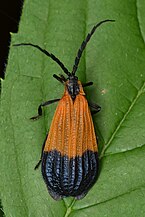Pyromorpha dimidiata
| Pyromorpha dimidiata | ||||||||||||
|---|---|---|---|---|---|---|---|---|---|---|---|---|

Pyromorpha dimidiata |
||||||||||||
| Systematics | ||||||||||||
|
||||||||||||
| Scientific name | ||||||||||||
| Pyromorpha dimidiata | ||||||||||||
| Herrich-Schäffer , 1854 |
Pyromorpha dimidiata is a butterfly fromthe ram family (Zygaenidae)found in North and Central America.
features
butterfly
Pyromorpha dimidiata reaches a wingspan of 18 to 22 millimeters. The forewings are elongated. The apex is strongly rounded. In terms of color, the top of the forewing is divided into two parts. The basal region is colored orange-yellow up to the middle of the disk region . From there the wing shows a dark gray to blackish color up to the hem. The upper side of the hind wing is solid dark gray. In the males the black antennae are strong, in the females weakly toothed. The proboscis is well developed.
Similar styles and mimicry
- In the very similar Lycomorpha pholus , the antennae are smooth and the dark forewing area is jet black.
- In their overall appearance, the adults of Pyromorpha dimidiata also resemble the red cap beetle Calopteron terminale , which is to be understood as mimicry . This is a “protective mimicry”, whereby potential predators are to be deterred by imitating role models. In the present case, the model Calopteron terminale is poisonous .
Occurrence and habitat
Pyromorpha dimidiata occurs in the eastern United States and Mexico . Deciduous forests and adjacent fields are preferred habitats.
Way of life
The diurnal moths fly from April to July, mainly in May. They like to visit different flowers to take in nectar. The caterpillars feed on oak leaves ( Quercus ).
Individual evidence
- ↑ Markku Savela: distribution. In: Lepidoptera and some other life forms. Retrieved March 14, 2020 .
- ↑ inaturalist.org flight time and photos
Web links
- BugGuide - Iowa State University information
- butterfliesandmoths - Butterflies and Moths of North America

